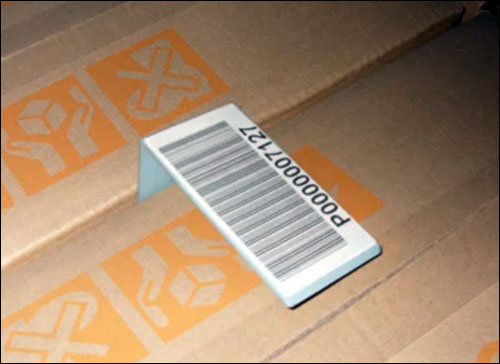Lion, one of the largest Thai manufacturers of cleaning products and other fast-moving consumer goods, employs radio frequency identification at one of its warehouses near its factory in southern Thailand, in order to improve its processes for storing and retrieving pallets carrying its products. The system, according to the company, has enabled the warehouse to reduce the amount of time required to complete a transfer order—defined as any movement of goods within the warehouse, such as relocating products into storage, or finding and removing them from storage to comply with an order—from 60 minutes down to roughly 10 minutes. What’s more, the technology has allowed Lion to increase the accuracy of its inventory records from about 80 percent (before RFID was implemented) to nearly 100 percent.
Lion began testing RFID in 2009, as part of a larger program called the Systematic Integration Strategy (SIS) project—a company-wide effort designed to improve the firm’s operational efficiency, as well as its coordination with supply chain partners.
The first phase of the SIS project (including the deployment of RFID within the warehouse) was completed in 2010, but Lion plans to expand its use of the solution to two additional warehouses, and has already begun feasibility testing at one of those other warehouses. The company hopes to deploy the RFID system at that site by the end of this year, says Sriyos Sudsertsin, a project manager at Lion.
Smartsoft Technology, an RFID systems integrator based in Thailand, worked with Lion to develop and implement the RFID solution. The firm selected UPM RFID‘s DogBone EPC Gen 2 passive ultrahigh-frequency (UHF) RFID inlay for the customized tags used in the system, with Sirit‘s Infinity 510 readers mounted on forklift trucks. The system employs RFID tags in two form factors—one used to identify pallets, and another to indicate the locations of shelves on which pallets are stored.
For the project, Smartsoft deployed its middleware, which controls the RFID hardware and maintains a Structured Query Language (SQL) database server that communicates with Lion’s SAP warehouse-management software. When a shipment arrives, the middleware collects order information from the SAP software. Workers then utilize a stationary RFID reader—the Sirit Infinity 510—to collect the ID number from a tag that will be attached to the pallet. The middleware then associates this number with the order information, along with a number identifying the pallet, after which a worker slips the pallet tag—a hard plastic tag with a tail, bent at 90 degrees to the tag’s face—between two boxes on the pallet.
Inside the forklift, a small touch-screen computer runs the Smartsoft middleware, and the driver uses that screen to learn where each pallet should be placed for storage, as well as where to collect pallets required to fulfill orders. The computer is linked to the main server at the warehouse, which runs the Smartsoft software and maintains the database, via a Wi-Fi connection. When the driver picks up a pallet, the software shows the warehouse location of the shelf at which that pallet should be placed.
While driving from the receiving area to the warehouse, the forklift drives through an RFID portal containing an Infinity 510 reader, which collects the pallet tag’s ID number. When the driver arrives at the shelf at which he or she has been directed to place the pallet, the RFID reader mounted on the vehicle collects the number of the tag permanently attached to the front of the shelf. The software then links the pallet and shelf tag IDs, in order to confirm the pallet’s location before the empty forklift departs, and the system changes the pallet’s status once more, therbey indicating that it has been accurately placed on a shelf.
When that pallet is later needed to fulfill an order, the Smartsoft software instructs the forklift driver to that same location, where he or she can then collect the pallet.
Upon leaving the warehouse area, the forklift moves through another gate containing the Infinity reader, which collects the pallet’s tag number one last time. The system then updates the pallet’s status in the Smartsoft software, indicating that it is headed out of the facility.
Before the pallet is shipped, its tag is removed. That tag can later be reused, upon being associated with a new, incoming pallet.
Employees also use Unitech RH767 II handheld readers to periodically make spot-checks throughout the warehouse. The workers utilize the readers to collect the numbers of the pallet and location tags, which the readers then forward to the Smartsoft software via a Wi-Fi connection. The software confirms that each pallet is in the proper place, and if a pallet is detected in the wrong location, the employee receives an alert so that he or she can have that pallet relocated to the correct area.
The project developers considered using bar-coded labels to identify the pallets and shelves, but the deep shelving units within the warehouse hold more than just one pallet. “The bar-code reader beam could not reach bar-code labels on the inner boxes,” Sudsertsin explains.
Before deploying the RFID system, forklift drivers sometimes placed pallets at an incorrect location within the warehouse. At other times, they might move one pallet in order to reach another located behind it, and then fail to reposition the first pallet at its correct location, thereby causing it to become lost. The RFID system prevents this from happening, by alerting drivers whenever a pallet has been placed at an incorrect spot. The Smartsoft software reduces the likelihood that the drivers will make such errors, since it alerts them in the event that pallets are misplaced.


